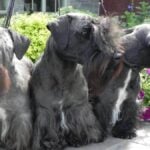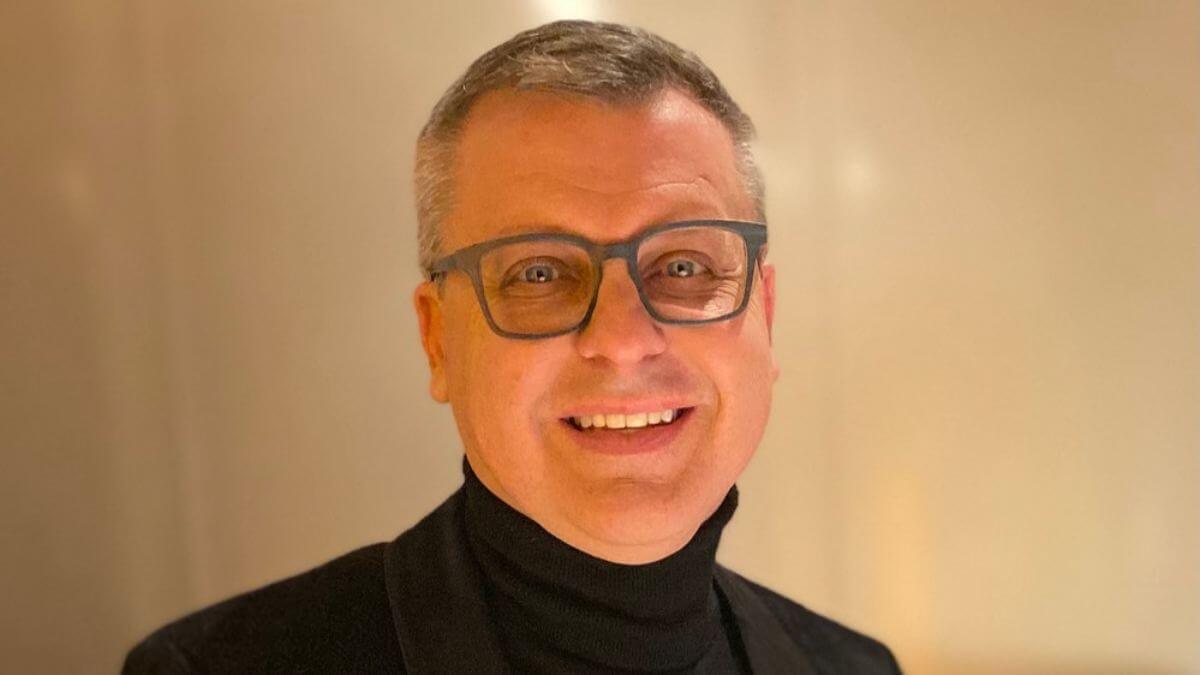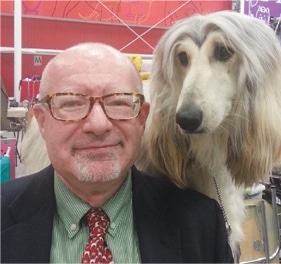
Home » Meet Doug Koger – Breeder of Domiko Azawakh

Doug Koger: I grew up in northern Georgia, in the small town of Calhoun.
Doug Koger: We always had dogs growing up. My first purebred dog was one my family adopted when I was very young, an Australian Shepherd named Thunder. After Thunder, we mostly had mixed breeds. A little later, my Mom, who loved Pekingese, got one, and had one or two until she passed. My first purebred dog that I bought for myself was an English Springer Spaniel. Well, he was mine until he and my Mom decided they loved each other more. After that, I had two Salukis and then was able to obtain my dream breed at the time who was also my first show dog, a Borzoi named Amigo (Ch. Tamarzi Earl Of Grey). I bought him with the agreement I would show him, and that is how my passion for showing dogs started.

Doug Koger: My mentors in the sport started when Amigo came to me. Through him, I met Marilynn Lockhart and her daughter, Tammy Ream-Beckworth. In turn, through them, I met Paula Moore. These three ladies were instrumental in guiding me through the ups and downs of showing. I still remember the day I visited Marilynn and Tammy, and was so proud of how I was moving Amigo. I thought I was doing everything correctly, until Marilynn told me he was pacing and how she hoped I hadn’t been teaching him that. I still smile at that memory as she then instructed me on the correct way to move the dog. Tammy was always there as well, to help me with the nuances of showing. She taught me a lot of the tips and tricks to be more skilled and professional in the ring. Paula was always there when I had questions, and to offer great grooming tips. She taught me how to groom a Borzoi to show off its best qualities, and hide some of the not-so-great qualities (although that doesn’t do me much good now with my current breed, the Azawakh). Without these three great ladies, I’m not sure I would be showing today.

Doug Koger: I study pedigrees intensively. I learned this from Paula Moore. She always taught me to look at the grandparents, not at the potential parents. The sire of my recent litter and my upcoming litter, GCH Seydou Of Silverdale, I purchased based on his pedigree alone. He had lines going back to some really old European dogs as well as new African genes. I also believe in linebreeding. I learned so much about the importance of this from my mentors and a man I met through them, Borzoi breeder Charles Tyson. While visiting Charles at his farm to drop off a bitch for breeding, we had an important and in-depth conversation. He shared that linebreeding is integral to maintaining type in a breed. I’m a bit of an outlier in my own breed at the moment as linebreeding is not an accepted practice. However, the most exciting litter I think I have ever planned is a future granddaughter-to-grandfather frozen semen breeding. The father is a World winner from the 1990s that exhibits incredible type. I believe this litter will go a long way toward ensuring that the breed maintains the type that distinguishes it from similar African sighthounds.

Doug Koger: Now, sir, in the dog world, isn’t that tantamount to asking a woman her age? Joking aside, I have six Azawakh and a Standard Poodle, along with a 12-year-old Borzoi that I rescued at one year of age. He will be my last Borzoi, I believe, as my focus now is on Azawakh and preserving this breed—and, more specifically, breed type. All of my dogs live in the house with me. Five of the Azawakh, including the puppy I kept (and that I am incredibly excited to get into the ring when she is old enough), sleep in the bed with me. Unfortunately, as Azawakh feel they must touch you at all times when sleeping, this was fine when I was younger, but not so comfortable now. The other Azawakh and the Standard Poodle sleep in their own room, as does the Borzoi who has his own room.

Doug Koger: I was at a dog show in Atlanta with my Borzoi. Across the exhibition hall I saw a man with three Azawakh. I didn’t even recognize the breed at that time but they took my breath away. Of course, I had to get a closer look and speak to the man, who introduced me to Azawakh and gave me tons of information on the breed. Through the beauty of the dogs and the passion this man exhibited, I knew I was drawn to the breed. That man is the reason Azawakh are known in the US, and his dogs are behind most of the Azawakh currently out there today. That man is Daoud Moore. When I decided I had to have an Azawakh, Daoud didn’t have any available but I was able to get my first through a Borzoi acquaintance of mine, Mary Childs, who had a litter. Omar was a magnificent Azawakh who started my love affair with the breed. A little later, my foundation dam and sire came to me from Daoud.

Doug Koger: When I first acquired the Azawakh, there was only the United Kennel Club and rare-breed shows where you could exhibit them. I dabbled in the UKC shows and won a Best in Show and a couple of Reserve Bests in Show with my foundation male, Bandar (Sheshonq Idiiyat-Es-Sahel). When the breed gained AKC acceptance in 2019, I was elated as this gave me the chance to get back into the ring after several years’ absence. I had imported a gorgeous female from Poland (GCHB Eidi n’Amanar) and when she was ready, took her to her first show in Fort Meyers, Florida. There, she won an Owner-Handled Group One. I was so surprised as I knew nothing about the NOHS at that time. I actually asked the judge if she was sure? She got a good laugh out of that, and told me to have more faith in my dog and to sharpen my handling skills. I took her advice to heart and now Ksenia, that female, has become the #1 Azawakh in NOHS since the breed began competing, and has achieved Platinum status. In addition, she is the only GCHB female in the breed. I hope this achievement shows exhibitors in all breeds that you can make your mark even if you are a novice. Learn how to present your dog to its best advantage and get out to the shows. For those of us in the rare breeds, this is how we get our breeds noticed, and it is also a great opportunity to educate others about your breed. Never hold back on your passion for the breed you love. Showing that passion goes a long way in getting others to demonstrate their excitement and determination.

Doug Koger: I believe it is the same in our sport as it is in just about anything else. People tend to focus on what they currently have. This may be because they just want to have a small hobby kennel to produce a single dog or two to show themselves. It may also be that it is hard to import dogs—and is even harder since August when dogs must reach six months of age in order to travel. It’s also incredibly expensive to import both dogs and semen. As someone whose kennel is made up almost entirely of imports, I know exactly how difficult and expensive this is. I believe these challenges make a lot of people give up on thinking more globally. With that said, I also know several people who work tirelessly in their breeds to import good dogs to add genetic diversity and bring pedigrees we don’t have to the US. Optimism is in my DNA. I truly believe that enough of us are passionate enough about our breeds that we will figure out ways to bring good dogs here and will continue to do so.
Doug Koger: As I said before, I’m an optimist at heart. That said, I see that we have areas of opportunity in our sport. Regarding the decline of breeders, we have to see that this is impacted by our economy. To properly health test and seek out the veterinary care needed to facilitate and see a pregnancy through until birth, and then properly care for the puppies, has gotten incredibly expensive. When you have other responsibilities, this makes it difficult or even prevents people from attempting to breed. We also have to face up to the fact that we need to be more welcoming and inclusive. I’ve been very lucky as I was embraced by those from whom I sought advice. But I also encountered people who were not willing to share or mentor as I progressed in the sport. Additionally, and there has been a lot of discussion about this lately due to some baffling decisions made by parent clubs, we must change how we respond to prospective club members. The current system of how people are voted in or out is archaic and flawed, in my opinion. There are far too many biases at play in many of our clubs that prevent good people from joining. I believe that we should open club memberships up to all who apply, and then let the bylaws of the club determine the rules of staying in the club. If we are to survive, we must be more open and accepting, as well as willing to teach and listen to newcomers to the sport. Let’s not forget that a lot of great ideas come from those with outside perspective.

Doug Koger: In the next decade I see myself doing exactly what I am doing now in this sport. I will be showing, and also producing litters that are true to type but also have a temperament suited to life here, outside of the harsh environment from which the breed originated. Temperament in the Azawakh is my soapbox. I don’t want to see the temperament of the breed watered down to where they are super-friendly dogs. But I do believe they have to adhere to the standards of life we have here. Aloof is fine; aggressive is not. They must be able to allow guests into your home; they must allow themselves to be touched; and they must be able to go out in public with us to social events and enjoy themselves without being nervous. If the breed is to survive outside of the very few of us presently working to preserve it around the world, it must adapt to our norms so that we can welcome in new people to take over when we are no longer here. That is what I will be doing over the next two decades, while also working to ensure that we welcome others in so that the breed continues to not just exist, but to thrive in this world that we brought them into.
Doug Koger: Outside of dogs, I work in management and consulting, while also dedicating time back to the community in which I live, by serving on the Board of the South Florida Wildlife Center. After working for Apple for 17 years, I decided the time had come for me to try new things, so I left and have done some consulting work and a few other things I’m working on now. I also love collecting mid-20th century Scandinavian glass as well as some turn-of-the-century American pottery. I am also an avid traveler who loves to seek out places that aren’t popular to visit, where I can immerse myself in new and unique cultures.

